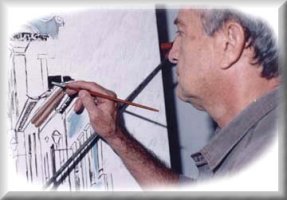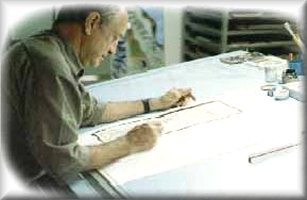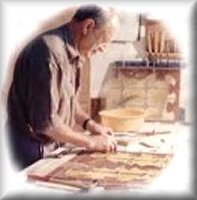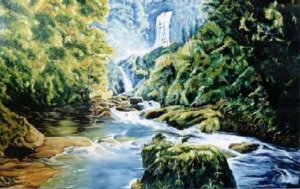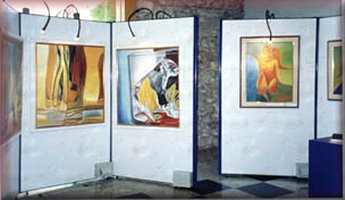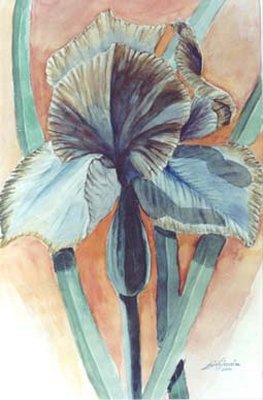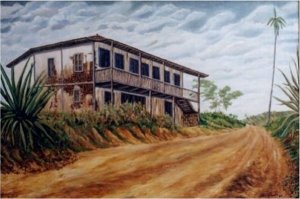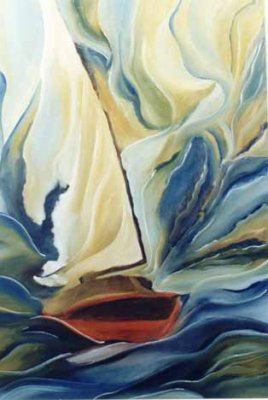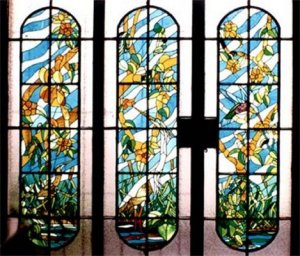|
|
Aluízio Cândido de Siqueira, artistic name Aluízio
Siqueira, since childhood revealed his artistic talents. When he arrived
each afternoon from the School Group, he passed his time making drawings
and perfecting, self taught, his artistic works.
In 1953, Aluízio Siqueira obtained the first prize in the second
Student Living room of plastic arts, and in the following year, Aluízio,
received honors, from the Second Living room.
|
|
| Aluízio was a designer and tape recorder for the Photogravure
Minas Gerais Ltd., no longer trading, and in 1953, he was a designer, tape
recorder and journalist (I Register n. 5.117/JP-DRT/MG) of the newspaper
S. A. Tribune of Mines. |
|
In that year,1953, Aluízio Siqueira met teacher Guignard,
who frequented the newspaper daily, and becoming friends, Aluízio
received from him much guidance in the techniques of drawing and painting.
|
|
|
In painting Aluízio Siqueira studied technique, history and artistic psychology.
He discovered and continues improving a new style, inside of the cubist
school, whose effects are characterized by a game of alive colors that gives
us a transparency effect. It assimilates that style with the abstract, whose
results are excellent. |
|
| Aluízio's works consist of oil painting, watercolor,
drawing, engraving, sculpture and stained glass. Aluízio Siqueira is an expert of the
graphic arts, because he had the opportunity to execute commercial and advertising
drawings and, with that, he had the opportunity of studying the techniques
of graphic arts, in fact these were utilized when he worked in the Photogravure
and in the Tribune of Mines. |
|
Aluízio Siqueira was the designer of the old Department
of Technical Police of Minas Gerais. Aluízio directed the delegation
of the mining Plastic Artists close to the first National Encounter of Professional
Plastic Artists, in Rio de Janeiro, in 1979. In that event, President of
the "Commission Discussion of the Studies of An Entity of National
Class of Plastic " Artists was chosen. |
|
|
He studied at the School Guignard, in the regular
course, however Aluízio didn't conclude the course of arts, for reasons
of service order, because Aluízio Siqueira had to do several and long trips. In that time,
he took the specialization course in sculpture with teacher Amilcar do Castro. |
|
| Together with painter Bracher Jr., deceased, Aluízio
founded the Association of the Plastic Artists of Minas Gerais. The Association
promoted to 1st Week of the Mining Plastic Artist, in 1979, and Aluízio
was chosen as general secretary of that encounter. Later, that Association
became the Union of the Artists Plastic Professionals of Minas Gerais, in
which he exercised some management positions. |
|
Teacher Calmon Barreto, excellent artist and former-director
of the National School of fine arts, in a letter to Aluízio made
excellent critic of his works. In the same way, the famous French artist,
Robert Tatin, going by Belo Horizonte, visited an exhibition of Aluízio
works and, through correspondence praised his works. |
|
|
In 1972, Aluízio Siqueira made two individual exhibitions, one
in the Hotel Excelsior and other in the Military Circle, both with great
success. He also made an individual exhibition in the city of Ferros, in
invitation of the City Hall, during the first week of the 'Cultural Day
of Ferros'. In 1974, together with his son Marco Túlio, he exhibited
in Jaraguá Country Club. |
|
| Aluízio was decorated with the title of
Commendatary of the Order of the Merit of the plastic arts of the National
Union of the Plastic Artists, in 1984. In 1995, Aluízio received
from the Club of the Lawyers of Minas Gerais the knighthood of Disloyal
Cláudio Manoel from Costa and respective diploma of the Judiciary
Merit. |
|
The last three of Aluízio individual exhibitions
were held in the cultural space of the Tribunal of Competence of Minas Gerais,
( l995); in the Tribunal of Justice of Minas Gerais, (1997/98) and in the
cultural space of the Federal savings bank, in the " fields "
of the Federal University of Minas Gerais, (April 1999). |
|
|
He also participated in several collective exhibitions, in Belo Horizonte
and other municipal districts.
The newspapers, magazines and TV made several reports and critics of his
works, in Brazil, Argentina and Uruguay.
|
|
| |
Stained
Glass
|
|
In the year of 1970, Aluízio Siqueira was interested in the
art of stained glass and he started to study the subject.

|
He had countless difficulties, because there was no literature in Portuguese,
neither was there suitable material in the Brazilian market, besides clear
glass, Brazil has little colored or stained glass.
For such, Aluízio created and set up a machine to extrude the
lead gutter, in form of H. He imported the tools and necessary machinery,
over and above it's ink.
|
|
